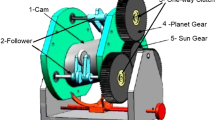Abstract
Continuously variable camphasers are now well established for modern spark-ignition engines in high-volume production. With the latest generation of camshaft adjustment systems using the vane-type actuator principle, it is possible to move rapidly and reliably through a large adjustment angle. The layout of these adjusting systems is very simple. The production costs are low in comparison to the first generation of camphasers using spur/helical gears to vary the valve timing. The new-generation systems are mechatronic, with the function depending on the coordination and tuning of hydraulic actuation and engine electronics. The term “VaneCAM” is used for the continuously variable systems of this new generation supplied by Hydraulik- Ring in Nürtingen, Germany.
Similar content being viewed by others
References
Haltenberger, S.: Vorrichtung zur Ventilverstellung. Patentschrift DE 368775, 1918
Bassi, A.; Arcari, F.; Perrone, F.: C.E.M.- The Alfa Romeo Engine Management System- Design Concepts-Trends for the future. SAEPaper 85 0290, 1985
Ulrich, J.; Fiedler, O.: Der Motor des neuen Porsche 968. In: MTZ 52 (1991), Nr. 12
Hannibal, W.; Meyer, K.: Patentrecherche und Überblick zu variablen Ventilsteuerungen. Vortrag Haus der Technik, März 2000
Bergmann, D.; Krause, G.; Niggemeyer, H.; Troll, H.: Der weiterentwickelte BMW-Sechszylinder mit Vierventiltechnik. In: MTZ 53 (1992), Nr. 10
Braun, H. S.; Flierl, R.; Kramer, Marder, R.; Schlerf, G.; Schopp, J.: Die neuen BMW Sechszylindermotoren. In: Der neue BMW 3er, Sonderausgabe ATZ und MTZ, 1998
Knecht, A.: Nockenwellenverstellsystem “Double-V-Cam”: Ein neues System für variable Steuerzeiten. In: Systems Partners 1998, Sonderausgabe ATZ und MTZ
Ebel, B.; Metzner, F.-T.: Die neuen V-Motoren von Volkswagen mit Doppelnockenwellenverstellung. In: MTZ 61 (2000), Nr. 12
Wenzel, C.; Stephan, W.; Hannibal, W.: Hydraulische Komponenten für variable Ventilsteuerungen. Vortrag Haus der Technik Essen, 2000
Endres, H.; Erdmann, H.-D.; Eiser, A.; Leitner, P.; Kaulen, W.; Böhme, J.: Der neue 3,0-I-V6- Ottomotor. In: Der neue Audi A4, Sonderausgabe der ATZ und MTZ, 2000
Rights and permissions
About this article
Cite this article
Knecht, A., Stephan, W. & Hannibal, W. “VaneCAM” the third generation of camshaft adjustment systems. MTZ Worldw 63, 15–18 (2002). https://doi.org/10.1007/BF03227533
Issue Date:
DOI: https://doi.org/10.1007/BF03227533




